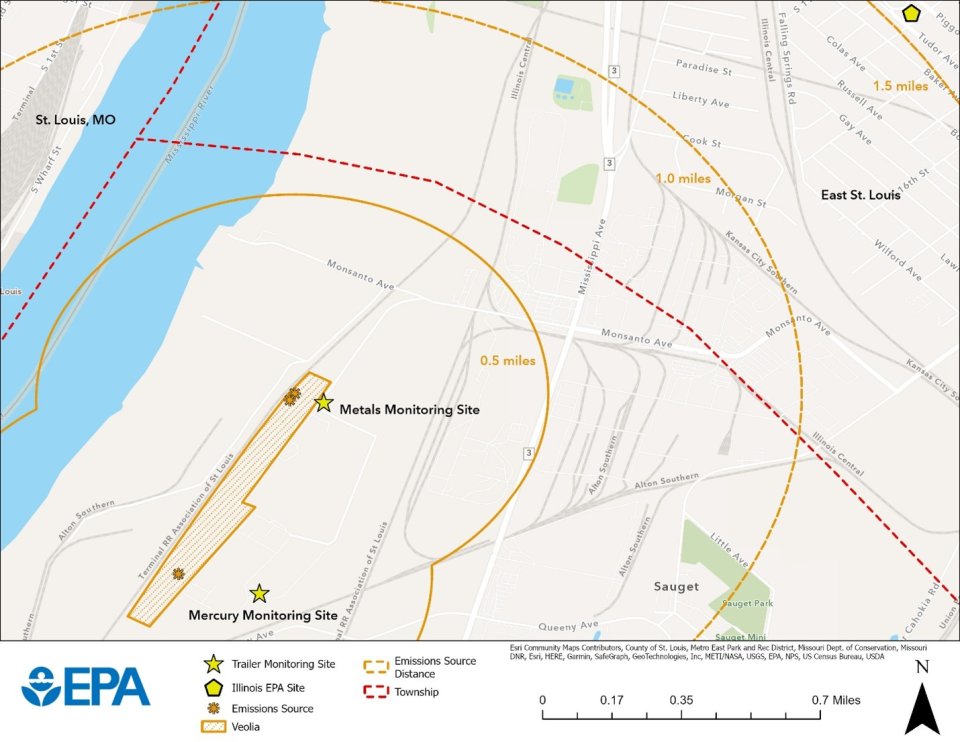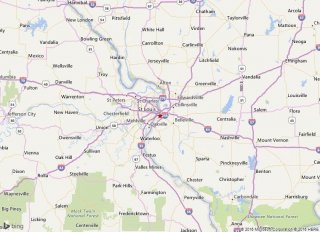Veolia Sauget Air Permitting
Veolia ES Technical Solutions stores and burns hazardous waste at its facility at 7 Mobile Ave., Sauget, Illinois. There have been longstanding environmental justice issues faced by the surrounding communities. The Biden-Harris Administration has directed federal agencies to develop programs, policies, and activities to address the disproportionate health, environmental, economic, and climate impacts on disadvantaged communities.
On this page:
- Public Engagement
- Clean Air Act Enforcement
- Air Monitoring
- Air Permitting
- Frequently Asked Questions
Public Engagement
Throughout the permitting process, EPA provides multiple public engagement opportunities to share developments in the permitting process and answer questions from the community. Information related to engagement opportunities for the current permitting process is available on the Public Engagement page.
Air Monitoring (Updated January 2023)
Overview
EPA conducted an air-monitoring study near Veolia’s facility from June 24, 2021, to March 4, 2022. EPA monitored for the pollutants that would be of greatest concern from this type of facility and the monitors did not detect anything that would have short- or long-term health effects for people living nearby. EPA monitored for this length of time, in part, to ensure that the data was representative of typical operations at the facility. No other site in the Midwest has been monitored this extensively for air impacts in the past two years.

Study Design
As shown on the map above, EPA operated two air-monitoring trailers over the 9-month study. Based on meteorology and air-dispersion modeling, EPA located the monitors to measure the highest levels of pollution from Veolia.
One monitoring trailer measured concentrations of 23 different metals on an hourly basis. For metals, it measured particles equal to or smaller than 10 µm in size (i.e., PM10). For reference, a human hair is typically 50-70 µm in diameter. This trailer also monitored wind speed, wind direction, temperature, and barometric pressure.
The other air-monitoring trailer measured different types of mercury: gaseous elemental mercury (5-minute), gaseous oxidized mercury (2-hour), and particulate-bound mercury (2-hour, 2.5 µm in size – i.e., PM2.5). Mercury monitoring ended on January 20, 2022, earlier than the metals monitoring, due to equipment availability.
Results
Based on metal concentrations collected and analyzed during EPA’s study, monitors did not record any values above levels expected to cause health impacts for people living near Veolia. To understand what the data means for the health of nearby residents, EPA compared the results to current health benchmarks, including the Agency for Toxic Substances and Disease Registry’s minimal risk levels (MRLs). Concentrations of metals were below both acute (short-term) and chronic (long-term) health benchmarks. EPA also calculated the potential cumulative cancer risk from breathing levels of these metals continuously for 70 years. The estimated cancer risk is well below EPA’s level for additional review.
Though not above acute (1-14 day exposure) or intermediate (15-364 day exposure) MRLs, there were a handful of 1-hour periods when concentrations of arsenic, antimony, total chromium, lead, nickel, divalent mercury, and particulate mercury increased. EPA is investigating these increases to learn more about Veolia’s operations and control effectiveness during these periods. As noted above, EPA also continues to investigate Veolia as part of an ongoing enforcement action.
It is worth noting that MRLs are intended to serve as screening tools to help public health professionals decide when to look at a pollutant more closely. To be protective and conservative, ATSDR sets MRLs below levels that, based on current information, may cause health effects. Exposure to a level above the MRL does not mean that health effects will occur. Rather, it indicates the need to look at a situation more closely.
Daily-averaged data summaries are available.
Veolia air monitoring data (xlsx) (80.65 KB, Jan. 2023)
ATSDR Health Consultation
In 2019, Senator Tammy Duckworth asked the federal Agency for Toxic Substances and Disease Registry (ATSDR) to conduct a health consultation study to determine whether pollution from the Veolia facility is affecting the community. When ATSDR reported that it did not have the data it would need for the study, EPA coordinated with ATSDR to conduct air monitoring. Now that ATSDR has the data needed, that study is moving forward. ATSDR’s health consultation study will be more in-depth than EPA’s analysis. If needed, ATSDR will make health-protective recommendations to prevent harmful exposures or to collect additional information.
Air Permitting
The Clean Air Act requires an operating permit – known as a Title V permit – for facilities that emit or have the capacity to emit large amounts of air pollution and for certain types of facilities that must comply with specific federal standards. Veolia is required to get a Title V permit because it is subject to federal standards for hazardous waste incinerators and because it has the capacity to emit large amounts of pollution.
Basic Information about Operating Permit
Permitting Actions
- 2023 Title V Permit Renewal Application
- 2019 Revised Title V Permit
- Veolia Settlement Agreement
- Final Part 71 Permit Renewal
- Part 71 Permit Renewal Support Documents
- Historical Documents
Veolia Sauget Air Permitting – Final Part 71 Permit Renewal
On June 17, 2019, the U.S. EPA issued a final revised Clean Air Act Title V renewal permit for Veolia’s hazardous waste incinerator in Sauget, Ill. The final permit revises the permit that EPA issued for the Veolia facility on January 18, 2017, consistent with the settlement agreement it reached with Veolia in March 2018.
The final permit does not change most requirements in the 2008 permit. However, EPA has added limits on how much arsenic, lead, mercury and other metals Veolia can put into its incinerators – known as the “feedrate limits” – as well as additional monitoring requirements to ensure that Veolia complies with its emissions limits. The 2019 permit also requires Veolia to install and operate mercury emissions controls on two incinerators that previously did not have mercury controls. Like the 2017 permit, the final 2019 permit continues to include significant improvements to Veolia’s feedstream analysis procedures.
The final permit, EPA’s responses to comments received during the public comment period, and other support documents, are found below. These documents are also available at www.regulations.gov; Docket ID No. EPA-R05-OAR-2014-0280.
Permit Renewal Documents
- Final Permit & Response to Comments documents, June 2019
- Final Permit & Response to Comments documents, January 2017
- Air Pollution Control Title V Permit to Operate Permit Renewal Documents, October 2014
Veolia Sauget Air Permitting – Part 71 Permit Renewal Support Documents
- Draft Permit , July 2018
- Statement of Basis , July 2018
- Additional Support documents and appendices
Comprehensive Performance Tests Reports
- 2018 Comprehensive Performance Test Report and appendices January 2019
- 2013 Comprehensive Performance Test Report and appendices January 2014
All documents relied upon in the permitting decision-making process can be found at www.regulations.gov; Docket ID No. EPA-R05-OAR-2014-0280.
Veolia Sauget Air Permitting – Historical Documents
Proposed January 2013 Air Permit Reopening
In January 2013 EPA proposed to reopen a Clean Air Act permit for a hazardous waste combusting facility in southern Illinois. U.S. EPA proposed this permit action for Veolia ES Technical Solutions LLC., 7 Mobile Ave., Sauget, Ill., near St. Louis, to modify its Clean Air Act Title V operating permit. The revised permit included “feedrate” limits for certain heavy metals. Feedrate limits are the maximum amount of heavy metals Veolia can feed into the incinerator combustion unit per hour. The heavy metals include mercury, arsenic and lead. The proposed permit also included additional requirements for monitoring the waste incinerated by Veolia at the facility.
U.S. EPA based the proposed feedrate limits, which comply with applicable regulations, on available performance test data. Veolia will continue operating the combustors following the requirements of their current permit until a final revised permit is issued. EPA held a public hearing on February 19, 2013 and accepted comments on the proposed permit reopening until April 1, 2013.
After taking comment on the draft reopening of Veolia’s permit, because of the timing of EPA’s proposal in relationship to the expiration of Veolia’s existing permit and the regulatory requirement for Veolia to perform compliance testing, EPA decided instead to incorporate revisions into Veolia’s permit at renewal.
All documents associated with the 2013 proposed reopening can be accessed at www.regulations.gov, Docket ID: EPA-R05-OAR-2012-0649.
2008 Initial Part 71 Permit
Veolia (formerly Onyx Environmental Services) submitted to Illinois Environmental Protection Agency (IEPA) on September 7, 1995, an application for a Title V permit for its facility in Sauget, Illinois. IEPA issued a draft Title V permit on June 6, 2003, and the public comment period for the permit ended September 12, 2003. During the public comment period, IEPA received comments on the draft permit. IEPA revised the permit and submitted the proposed permit to EPA on November 6, 2003. EPA did not object to the proposed permit within its 45-day review period, which ended December 21, 2003.
On February 18, 2004, EPA received a petition from the Sierra Club and American Bottom Conservancy requesting that EPA object to issuance of the Veolia Title V permit, pursuant to Section 505(b)(2) of the CAA and 40 C.F.R. § 70.8(d). On February 1, 2005, EPA issued an order granting the petition in part and denying it in part. Pursuant to 40 C.F.R. § 70.8(c), this action started a 90-day period during which IEPA was required to issue a revised Title V permit that addressed the issues raised in the February 1, 2005 order. IEPA did not issue the permit within the 90-day window. The Sierra Club and the American Bottom Conservancy sued EPA, alleging that EPA had a duty to issue the permit following the State of Illinois’ failure to timely issue the revised permit.
On September 29, 2006, EPA announced its intent to issue or deny a federal Title V permit. Veolia submitted a Part 71 permit application to EPA on May 2, 2007. EPA deemed the application administratively complete on June 13, 2007. EPA issued a final Part 71 permit on September 12, 2008.
All documents associated with the 2008 permit can be accessed at www.regulations.gov, Docket ID: EPA-R05-OAR-2008-0235.
Contact Information
Jason Schenandoah (enforcement)
(schenandoah.jason@epa.gov)
312-886-9506
Katherine Haile (monitoring)
(haile.katherine@epa.gov)
312-886-6439
David Ogulei (permitting)
(ogulei.david@epa.gov)
312-353-0987
Site-Specific Risk Assessment
At the request of the Illinois Attorney General and the Illinois EPA, U.S. EPA has updated its 2007 site-specific risk assessment for the Veolia facility in Sauget, Illinois. U.S. EPA’s report analyzes potential emissions from the three hazardous waste incinerators that Veolia ES Technical Services, L.L.C. owns and operates in Sauget. The incinerators are regulated under Illinois EPA’s Resource Conservation and Recovery Act (RCRA) permit and U.S. EPA’s 2019 Clean Air Act Title V permit.
The risk assessment demonstrates that compliance with current feed-rate limits in the federal Title V permit should be protective of public health in the area near the facility. U.S. EPA also recommends that Illinois EPA consider including emission limits for mercury and chromium in its RCRA permit.

